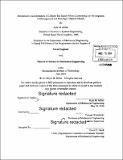Mechanical characterization of lithium-ion battery micro components for development of homogenized and multilayer material models
Author(s)
Miller, Kyle M. (Kyle Mark)
DownloadFull printable version (12.70Mb)
Other Contributors
Massachusetts Institute of Technology. Department of Mechanical Engineering.
Advisor
Tomasz Wierzbicki.
Terms of use
Metadata
Show full item recordAbstract
The overall battery research of the Impact and Crashworthiness Laboratory (ICL) at MIT has been focused on understanding the battery's mechanical properties so that individual battery cells and battery packs can be characterized during crash events. The objective of this research is to better understand the battery component (electrode and separator) properties under different loading conditions. In this work, over 200 tests were conducted on battery components. These tests include uniaxial stress, biaxial punch, multilayer, single layer, short-circuit testing, wet vs dry specimen testing, strain rate testing, and more. Additionally, a scanning electron microscope was used to view the battery components at a micro level for the purpose of better understanding the aforementioned test results. During these tests, it was observed that many of the electrodes in the Li-ion batteries are damaged during the battery manufacturing process. Also, the two methods of manufacturing battery separator were analyzed and their resulting mechanical properties were characterized. These results will be used to further refine and validate a high-level, robust, and accurate computational tool to predict strength, energy absorption, and the onset of electric short circuit of batteries under real-world crash loading situations. The cell deformation models will then be applied to the battery stack and beyond, thereby enabling rationalization of greater optimization of the battery pack/vehicle combination with respect to tolerance of battery crush intrusion behavior. Besides improving crash performance, the finite element models contribute substantially to the reduction of the cost of prototyping and shorten the development cycle of new electric vehicles.
Description
Thesis: Nav. E., Massachusetts Institute of Technology, Department of Mechanical Engineering, 2014. Thesis: S.M., Massachusetts Institute of Technology, Department of Mechanical Engineering, 2014. Cataloged from PDF version of thesis. Includes bibliographical references (page 60).
Date issued
2014Department
Massachusetts Institute of Technology. Department of Mechanical EngineeringPublisher
Massachusetts Institute of Technology
Keywords
Mechanical Engineering.